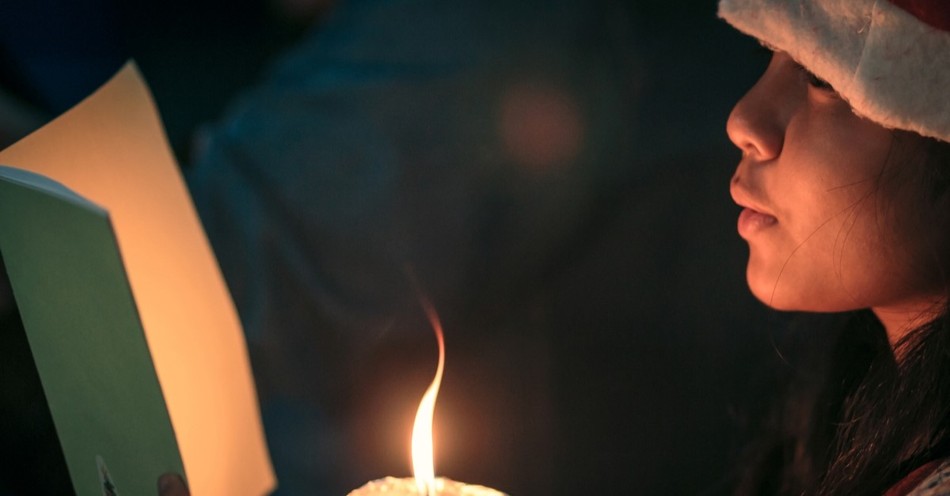The Huron Carol has been a staple of Canadian Christmas carols for a long time. The haunting yet comforting melody of the Huron Carol echoed through the wooded lands of Canada over 200 years before the modern inception of Canada’s current state on July 1, 1867. The Huron Carol was forged by mixing native and European cultures, which characterized much of the early history of Canada.
What Was Else Is the Huron Carol Known As?
Alternate names for the Huron Carol include:
- “Jesous (or Iesous) Ahatonnia,” which means “Jesus is born” in the Wendat language.
-“‘Twas in the Moon of Wintertime”
- “The First Canadian Christmas Carol”
Who Wrote the Huron Carol?
Jean de Brébeuf composed “Iesous Ahatonnia” in the early 1640s. Brébeuf was a Jesuit missionary who came to Canada in June 1625. The following summer, he and a few others followed a group of native traders back to the small village of Toanché of the Bear Clan of the Wendat Community. French settlers nicknamed the Wendat “Huron,” meaning “boar’s head,” and both terms have been used since then.
After arriving in 1625, Brébeuf spent his first two years learning Wendat customs, beliefs, and language. His mastery of the culture and language proved to be an indispensable asset to his mission. During his time with the Wendat community, Brébeuf composed “Iesous Ahatonnia” in the Wendat language to tell them about the Advent of Jesus Christ in relatable terms and expressions. Only later would the song come to be known as the Huron Carol.
Brébeuf’s life ended in tragedy when Iroquois killed him on March 16, 1649. His martyrdom gave him a place among the Canadian Martyrs.
The history of the Huron Carol is both rich and sophisticated. According to a Broadview article by Will Pearson, the first known reference to the Huron Carol came through the dispatches of François-Joseph Le Mercier, a late seventeenth-century Jesuit priest. In a letter sent to his leadership in France, Le Mercier wrote of a dying native girl who sang about the birth of Jesus on her deathbed. The surviving Wendat community preserved the Huron Carol through oral tradition until a Jesuit priest recorded the words in the eighteenth century.
It appears Brébeuf formed the Huron Carol to the melody of an old French folk song, “Une Jeune Pucelle,” which means “A Young Maid.” As of this writing, no writings of the original song have been recovered, so it’s unknown if Brébeuf recorded the Huron Carol or transmitted it orally.
Is There an English Version of the Huron Carol?
Jean de Brébeuf composed his lyrics for “Iesous Ahatonnia” in the language of the Wendat people who occupied the southern region of Canada by the Great Lakes.
After the original lyrics were composed in the early 1600s, Canadian poet and songwriter Jesse Edgar Middleton produced an anglicized version of the Huron Carol in 1926. The lyrics appear in many Canadian church hymnals, particularly in Methodist and Anglican churches.
Over time, many more variations on the song have appeared. For example, Canadian folk musician and indigenous rights activist Bruce Cockburn provided a new English version of the song for his 1993 album Christmas.
In a December 19, 1993 radio interview with NPR’s Liane Hansen, Cockburn stated that he received help translating the original lyrics from John Steckley, a linguist from the University of Sudbury in Ontario. This was no small feat considering that much Wendat culture was lost in the Iroquois Confederation’s battles during the seventeenth century.
What Makes the Huron Carol Controversial?
The lyrics of Middleton’s more popular, modern version of the Huron Carol caused no shortage of controversy. On the one hand, the song has been a long-standing reminder of the Wendat community, which was all but wiped out by the Iroquois Confederacy. It has been a treasured part of Canada’s history.
On the other hand, the modern version’s changes (some would say corruptions) are seen by others as a European viewpoint disregarding or mocking ancient indigenous culture. One example is the mention of “Gitchi Manitou,” which means “Great Spirit.” The term comes from the Algonquian culture, not the Wendat. To many listeners, the change embodies a disregard for the Wendat community, perhaps even Native American cultures at large.
Interest in recovering Wendat culture has developed over recent decades as the remaining Wendat community looks to recover the roots of their ancestry. Greater attention to their heritage has led to increased rejection of the modern version of the Huron Carol. Nevertheless, the song continues to be a staple at Christmas time in Canada and is sung and enjoyed by many.
Other versions of the song continue to be produced, many aimed at exploring its Wendat heritage while making the song accessible to other underrepresented groups. For example, musician Heather Dale released this version in 2017 that features the song in English and French, but also sign language and Wendat:
What Biblical Accounts Does the Huron Carol Reference?
The Huron Carol references two key Bible stories. It references the birth narrative of our Lord and Savior Jesus Christ, recorded in Matthew 1 and Luke 2.
It also references the visit of the Magi, which is only mentioned once in the Bible:
“Now after Jesus was born in Bethlehem of Judea in the days of Herod the king, behold, wise men from the East came to Jerusalem, saying, “Where is He who has been born King of the Jews? For we have seen His star in the East and have come to worship Him.”
When Herod the king heard this, he was troubled, and all Jerusalem with him. And when he had gathered all the chief priests and scribes of the people together, he inquired of them where the Christ was to be born.
So they said to him, “In Bethlehem of Judea, for thus it is written by the prophet:
‘But you, Bethlehem, in the land of Judah,
Are not the least among the rulers of Judah;
For out of you shall come a Ruler
Who will shepherd My people Israel.’ ”
Then Herod, when he had secretly called the wise men, determined from them what time the star appeared. And he sent them to Bethlehem and said, “Go and search carefully for the young Child, and when you have found Him, bring back word to me, that I may come and worship Him also.”
When they heard the king, they departed; and behold, the star which they had seen in the East went before them, till it came and stood over where the young Child was. When they saw the star, they rejoiced with exceedingly great joy. And when they had come into the house, they saw the young Child with Mary His mother, and fell down and worshiped Him. And when they had opened their treasures, they presented gifts to Him: gold, frankincense, and myrrh.” (Matthew 2:1-12)
In keeping with the Jesuit strategy of assimilation and adaption, the lyrics of both versions of the song speak of Jesus’ Advent in terms tailored to the culture to which it was addressed. While debates continue about whether the strategy sometimes became condescending, the principle behind it was well-intentioned and raises good questions.
The adaptation-assimilation strategy gives Christians an important question: how much adaptation is too much? We think of the Apostle Paul’s statement: “. . . I have become all things to all men, so that I may by all means save some” (1 Corinthians 9:22 NASB). Paul understood the importance of using Christian liberty to adapt wherever possible to bring the Gospel to all people groups. At the same time, he knew where to draw the line. A Christian should never adapt at the expense of biblical truth, especially the truth of the Gospel. All those who worship God must worship Him in spirit and truth (John 4:23).
Whether you enjoy the Huron Carol or have reservations about it, all Christians should examine themselves to see if they share Paul’s attitude: adapting responsibly to all people to win souls to Christ through His glorious Gospel.
Photo Credit: © Getty Images/Boonyachoat

This article is part of our larger Christmas and Advent resource library centered around the events leading up to the birth of Jesus Christ. We hope these articles help you understand the meaning and story behind important Christian holidays and dates and encourage you as you take time to reflect on all that God has done for us through His Son, Jesus Christ!
What Is Advent: Meaning, History, and Traditions
Advent Prayers for Friends, Family, and More
What Is an Advent Wreath and How to Use One?
The History of Santa Claus: Origin of St. Nicholas
Christmas Bible Verses & Scripture Story
What is Christmas? True Meaning and Holiday History
Christmas Eve History and Traditions
Why Gold, Frankincense, and Myrrh?
When Was Jesus Born? Why December 25th
Where Was Jesus Born?



_639003522088907085.jpg)